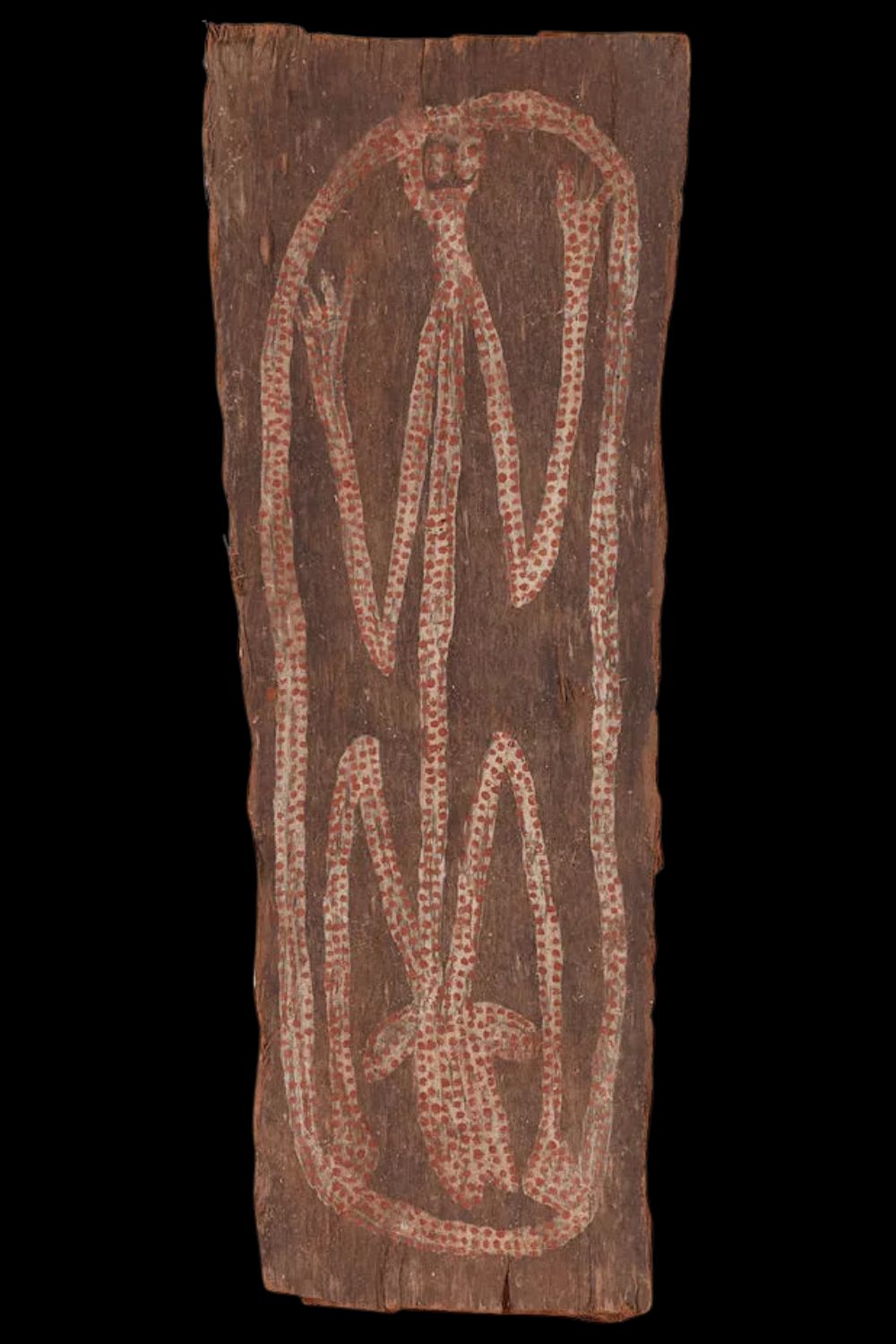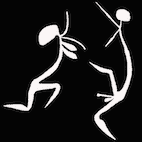Diidja Early Oenpelli Bark paintings
Diidja also known as Madidja Mandidi or Mandidaidai was a powerful and deeply spiritual artist whose bark paintings reflect the archaic rock art traditions of Western Arnhem Land. Executed with remarkable freedom and fluidity, his works often feature white kaolin figures filled with fine red dotting, a technique reminiscent of early Mick Kubarrku compositions. Set against monochrome ochre backgrounds, these figures—drawn from the spirit world—possess an elemental force that transcends decorative intent. The irregular edges of his barks and their early collection dates suggest they were created before the commercial bark painting movement of the 1960s, which explains the rarity of his surviving works. Though only a handful of examples are known, Diidja’s distinctive style—marked by its bold restraint, spiritual resonance, and spontaneous execution—places him among the most compelling of Arnhem Land’s early painters and underscores his deserving place in the canon of great Aboriginal artists.
If you have a Diidja bark painting to sell please contact me. If you just want to know what your bark painting is worth to me please feel free to send me a Jpeg. I would love to see it.
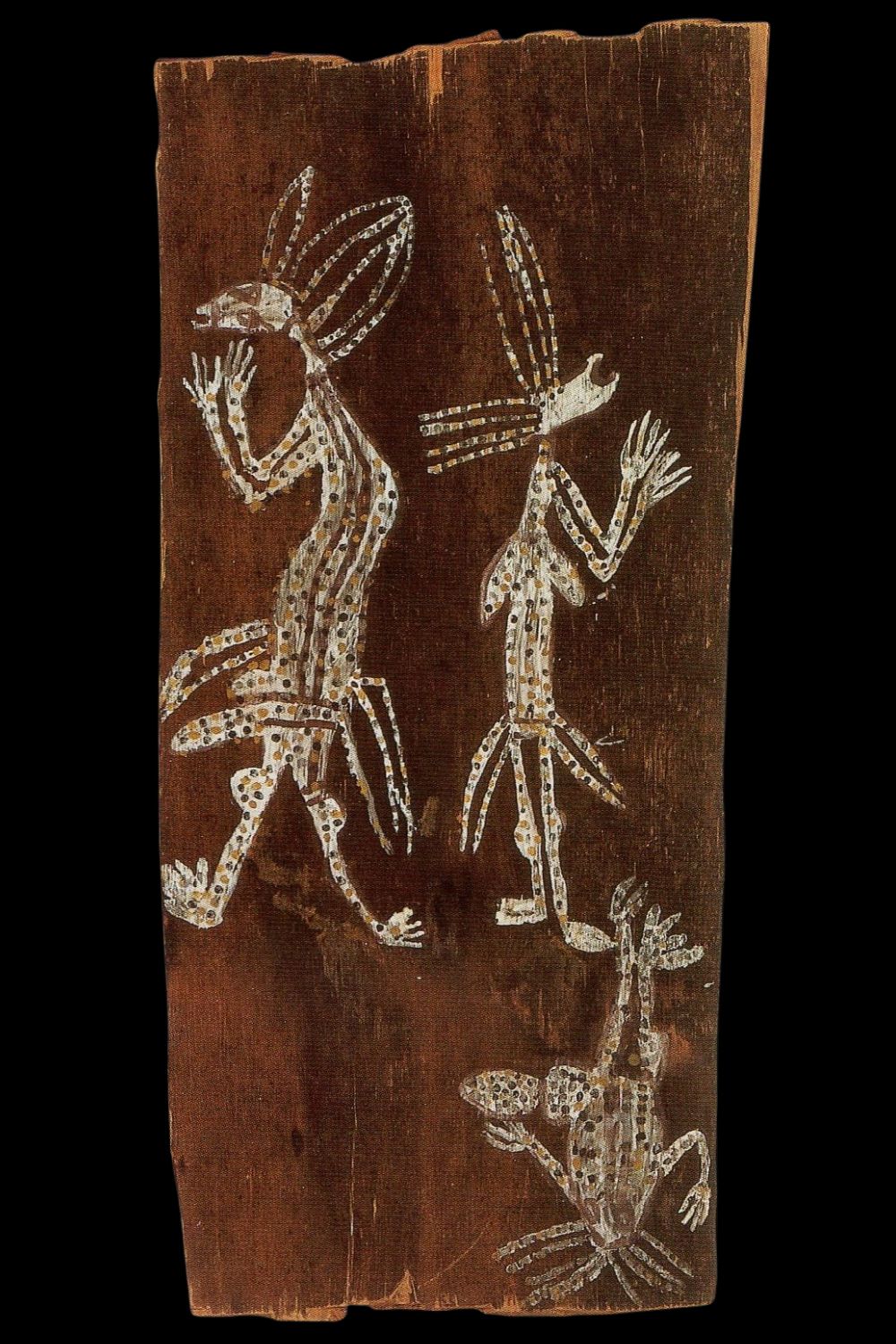
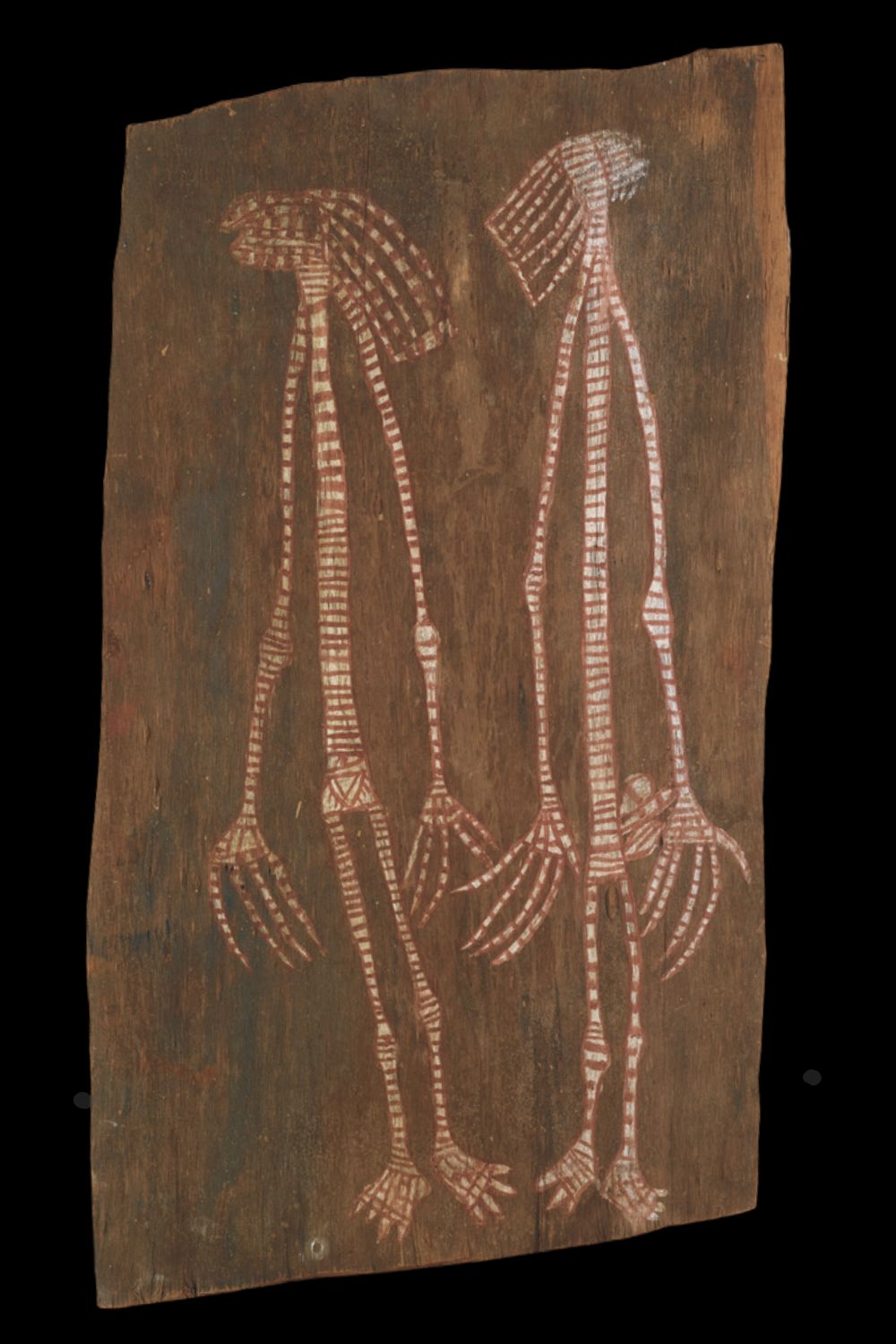
Painting Style
Diidja was a powerful and deeply spiritual artist whose bark paintings reflect the archaic rock art traditions of Western Arnhem Land. Executed with remarkable freedom and fluidity, his works often feature white kaolin figures filled with fine red dotting, a technique reminiscent of early Mick Kubarrku compositions. Set against monochrome ochre backgrounds, these figures—drawn from the spirit world—possess an elemental force that transcends decorative intent. The irregular edges of his barks and their early collection dates suggest they were created before the commercial bark painting movement of the 1960s, which explains the rarity of his surviving works. Though only a handful of examples are known, Diidja’s distinctive style—marked by its bold restraint, spiritual resonance, and spontaneous execution—places him among the most compelling of Arnhem Land’s early painters and underscores his deserving place in the canon of great Aboriginal artists.
His bark paintings can only really be compared to other very early Oenpelli artists like Najombolmi or Nym Djimurrgurr.
Biography
Diidja belonged to the Kunwinjku people in Western Arnhem Land and was born around 1900 and died in 1963. Along with many other Arnhem Land Artists who did bark paintings, there is not a lot of information available about Diidja / Mandidja. If anyone knows more information about the biography of Diidja please contact me as I would like to add it to this article.
Diidja is also called Madidja | Mandidi | Mandidaidai.
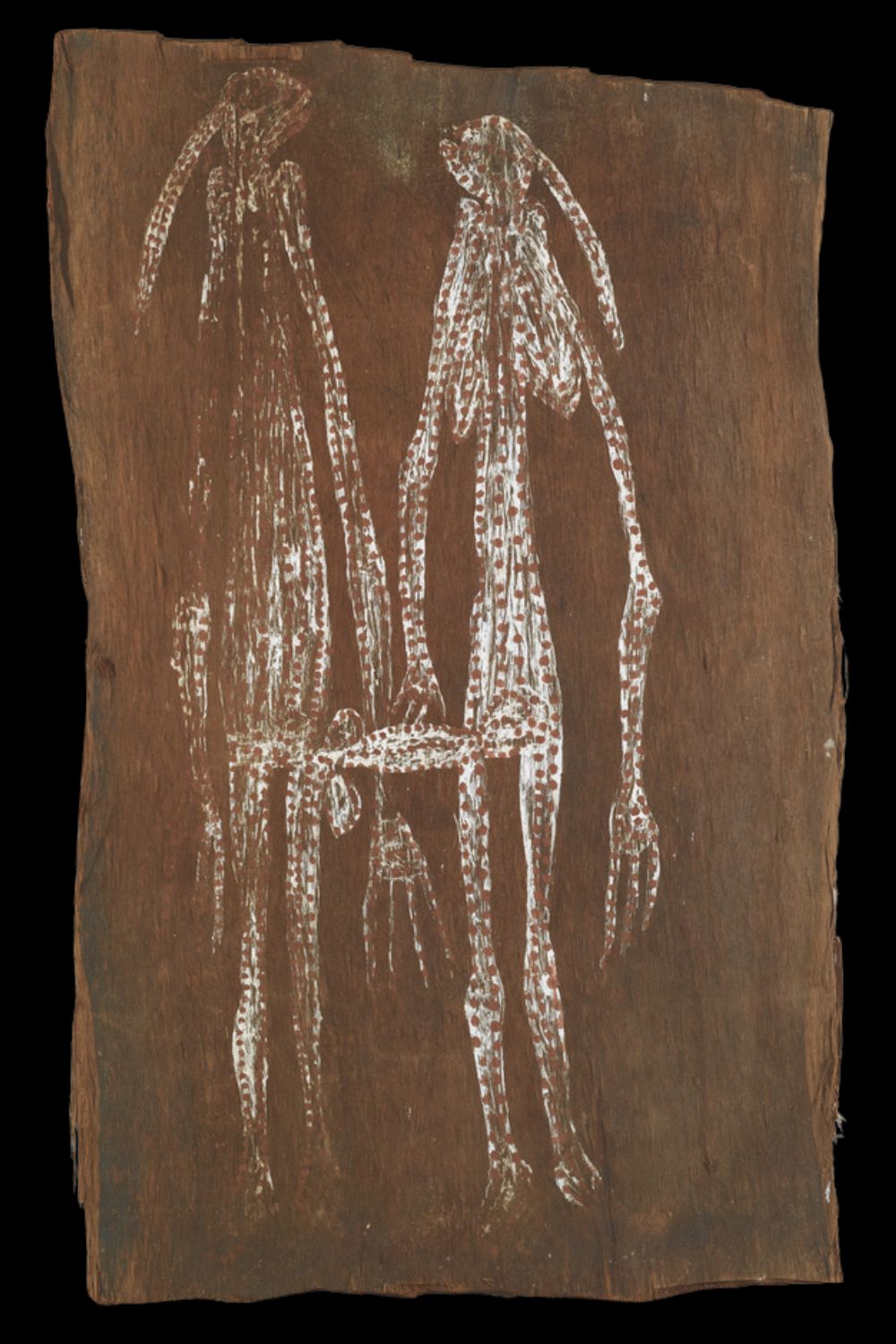
All images in this article are for educational purposes only.
This site may contain copyrighted material the use of which was not specified by the copyright owner.
Meaning of Diidja Bark Paintings

Namorrordo: Malicious Spirit of the Shooting Star
‘In large holes in the vast, rocky Arnhem Land plateau, which the Aborigines refer to as “the stone country” live malicious spirits called Namarnde or namorrordo. These are long-haired people with very thin bodies (“just a little muscle over their bones”) and long, slender fingers tipped with long nails.
Namarnde are considered to be dangerous to humans. In the daytime, they stay quietly in their cool holes in the stone country. At dusk they begin to prowl abroad, uttering high-pitched cry: “Go-wed!”. After nightfall, they go on a “sneaking walkabout” across the sky, looking for a solitary, sleeping Aborigine whose liver and kidney they will remove. This is a practice also favoured by malicious human sorcerers: when the victim awakens, there is no mark on his or her body. In three or four days the person dies.
Namarnde were sometimes glimpsed on their prowls by the ‘old people’ (past generations), who would subsequently paint the image on a rock face or on the inner walls of their bark huts so as to show people what a namurrordo looked like.
Today namorrordo are always invisible to people except when, during their night-time prowls in the sky, they show themselves for a few seconds as a falling star divided across the heavens.
Namarrkon the Lightning Spirit in the Work of Diidja
Namarrkon, the ancestral Lightning Spirit of Western Arnhem Land, is a potent presence in the bark paintings of early Arnhem Land artist Diidja, also known as Mandidi. Revered as the spiritual force behind the violent monsoonal storms of the Kunumeleng season, Namarrkon is not simply a mythological figure in Diidja’s work but a living ancestral being—his power encoded in pigment, form, and cultural law. During the dry season, Namarrkon resides in a sacred billabong near Numbuwah, east of Koongarra, watching the sky and his estranged wife through a hole in a nearby stone pillar—an eye left behind at his Dreaming site, Namarrkondjadjan.
In Diidja’s barks, Namarrkon is rendered with stark, spiritual force—figures outlined in white kaolin and filled with fine red dotting on ochre ground, reflecting an aesthetic inherited directly from ancient rock art. These images, often stripped of decorative rarrk, instead emphasise form, movement, and mythic power. As Namarrkon ascends into the clouds each October, his fury grows: he beats thunder from stone axes affixed to his elbows and knees, ejects lightning from rods that spiral from his ears to his genitals, and signals the ripening of bush foods. By January, his storms split trees and shake the land.
Diidja’s paintings of Namarrkon reflect this elemental energy—expressive, untamed, and spiritually charged. The blue and orange Leichhardt’s grasshoppers, Namarrkon’s spirit children, are also hinted at in ceremonial context. His lagoon remains a place of danger and reverence, strictly avoided. Through bark painting, Diidja preserved Namarrkon’s presence not just as story but as law, mapping the cycles of season and spirit with a visual language that is raw, ancient, and enduring.
